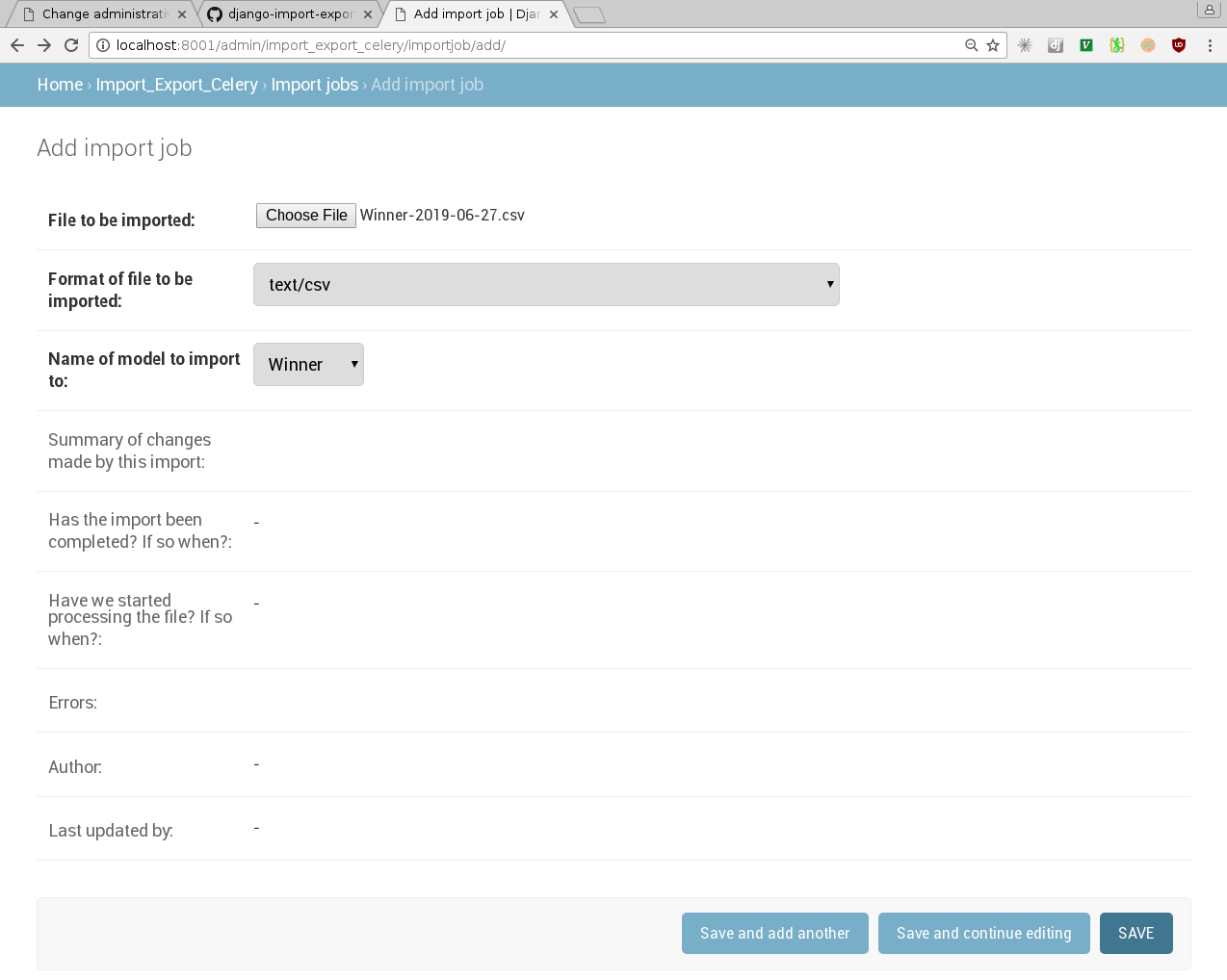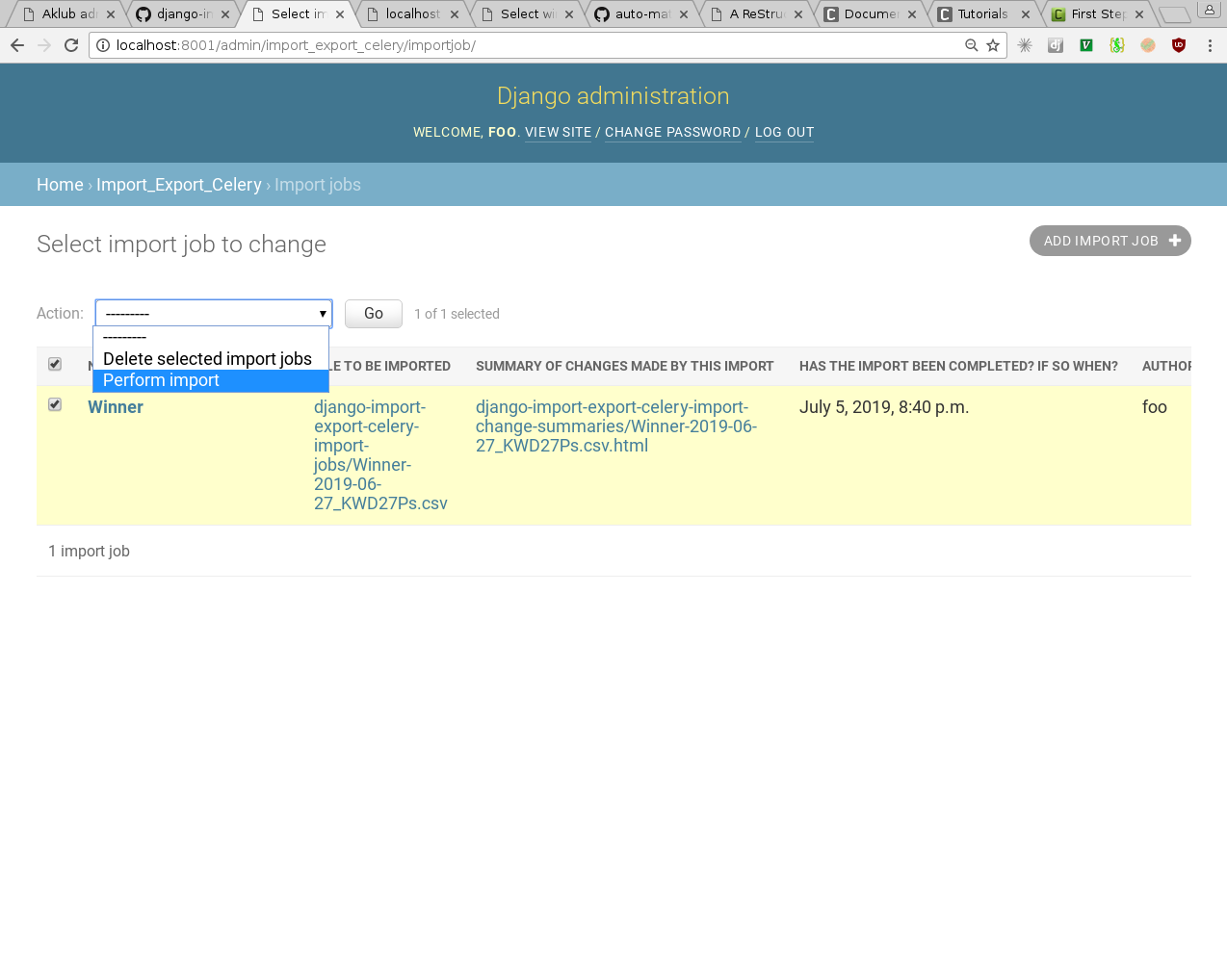
django-import-export-celery: process slow django imports and exports in celery
django-import-export-celery helps you process long running imports and exports in celery.
Basic installation
Set up celery to work with your project.
Add
'import_export_celery'to yourINSTALLED_APPSsettings variableAdd
'author.middlewares.AuthorDefaultBackendMiddleware'to yourMIDDLEWARE_CLASSESConfigure the location of your celery module setup
IMPORT_EXPORT_CELERY_INIT_MODULE = "projectname.celery"
Setting up imports with celery
A fully configured example project can be found in the example directory of this repository.
Perform the basic setup procedure described above.
Configure the IMPORT_EXPORT_CELERY_MODELS variable.
def resource(): # Optional from myapp.models import WinnerResource return WinnerResource IMPORT_EXPORT_CELERY_MODELS = { "Winner": { 'app_label': 'winners', 'model_name': 'Winner', 'resource': resource, # Optional } }The available parameters are app_label, model_name, and resource. 'resource' should be a function which returns a django-import-export Resource.
Done
By default a dry run of the import is initiated when the import object is created. To instead import the file immediately without a dry-run set the IMPORT_DRY_RUN_FIRST_TIME to False
IMPORT_DRY_RUN_FIRST_TIME = False
Preforming an import
You will find an example django application that uses django-import-export-celery for importing data. There are instructions for running the example application in the example directory's README file. Once you have it running, you can perform an import with the following steps.
Navigate to the example applications admin page:

Navigate to the ImportJobs table:

Create a new import job. There is an example import CSV file in the example/example-data directory. Select that file. Select csv as the file format. We'll be importing to the Winner's model table.

Select "Save and continue editing" to save the import job and refresh until you see that a "Summary of changes made by this import" file has been created.

You can view the summary if you want. Your import has NOT BEEN PERFORMED YET!

Return to the import-jobs table, select the import job we just created, and select the "Perform import" action from the actions drop down.

In a short time, your imported Winner object should show up in your Winners table.

Setting up exports
As with imports, a fully configured example project can be found in the example directory.
- Add a export_resource_classes classmethod to the model you want to export.
@classmethod def export_resource_classes(cls): return { 'winners': ('Winners resource', WinnersResource), 'winners_all_caps': ('Winners with all caps column resource', WinnersWithAllCapsResource), }This should return a dictionary of tuples. The keys should be unique unchanging strings, the tuples should consist of a resource and a human friendly description of that resource.
- Add the create_export_job_action to the model's ModelAdmin.
from django.contrib import admin from import_export_celery.admin_actions import create_export_job_action from . import models @admin.register(models.Winner) class WinnerAdmin(admin.ModelAdmin): list_display = ( 'name', ) actions = ( create_export_job_action, )
- To customise export queryset you need to add get_export_queryset to the ModelResource.
class WinnersResource(ModelResource): class Meta: model = Winner def get_export_queryset(self): """To customise the queryset of the model resource with annotation override""" return self.Meta.model.objects.annotate(device_type=Subquery(FCMDevice.objects.filter( user=OuterRef("pk")).values("type")[:1])
Done!
Performing exports with celery
- Perform the basic setup procedure described in the first section.
- Open up the object list for your model in django admin, select the objects you wish to export, and select the Export with celery admin action.
- Select the file format and resource you want to use to export the data.
- Save the model
- You will receive an email when the export is done, click on the link in the email
- Click on the link near the bottom of the page titled Exported file.
Excluding export file formats in the admin site
All available file formats to export are taken from the Tablib project.
To exclude or disable file formats from the admin site, configure IMPORT_EXPORT_CELERY_EXCLUDED_FORMATS django settings variable. This variable is a list of format strings written in lower case.
IMPORT_EXPORT_CELERY_EXCLUDED_FORMATS = ["csv", "xls"]
Customizing File Storage Backend
Define a custom storage backend by adding the IMPORT_EXPORT_CELERY_STORAGE to your Django settings. For instance:
IMPORT_EXPORT_CELERY_STORAGE = "storages.backends.s3boto3.S3Boto3Storage"
Customizing email template for export job completion email
By default this is the subject and template used to send the email
Subject: 'Django: Export job completed' Email template: 'email/export_job_completion.html'
The default email template can be found here
The default email subject and template can be customized by overriding these values from django settings:-
EXPORT_JOB_COMPLETION_MAIL_SUBJECT="Your custom subject" EXPORT_JOB_COMPLETION_MAIL_TEMPLATE="path_to_folder/your_custom_template.html"
The email template will get some context variables that you can use to customize your template.
{
export_job: The current instance of ExportJob model
app_label: export_job.app_label
model: export_job.model
link: A link to go to the export_job instance on django admin
}
For developers of this library
You can enter a preconfigured dev environment by first running make and then launching ./develop.sh to get into a docker compose environment packed with redis, celery, postgres and everything you need to run and test django-import-export-celery.
Before submitting a PR please run flake8 and (in the examples directory) python3 manange.py test.
Please note, that you need to restart celery for changes to propogate to the workers. Do this with docker-compose down celery, docker-compose up celery.
Commercial support
Commercial support is provided by gradesta s.r.o.
Credits
django-import-export-celery was developed by the Czech non-profit auto*mat z.s..